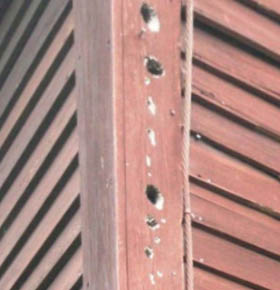Q: We have a number of woodpecker holes in our wood fascia and corner boards and are looking for suggestions for how keep them away. The activity seems to be mostly in the spring when we often hear a loud rat-a-tat sound in the mornings. We’ve even caught sight of them in the morning. They seem to be downy or hairy woodpeckers, not the large pileated type. — DH
A: I have dealt with a similar problem with red cedar corner boards that were full of holes from top to bottom. For whatever reason, they mainly attacked one corner board on the southeast corner of the house.

I spoke with an animal control expert who suggested trying sparkly streamers or other shiny objects to scare them off.
Other experts have suggested similar efforts with mylar balloons, pinwheels, reflective tape or owl decoys. Draping burlap or bird netting from the eaves over the affected area can also work if the damage is in the eaves. In one study reported by the Cornell Lab of Ornithology, streamers were the most consistently effective deterrent.
Composite Decking & Trim Boards
None of these solutions were very appealing to me, so I decided to replace the corner board with solid composite decking. The 5/4×6 profile was just the right size and I found a near-perfect color match to the weathered cedar trim.
Composite or PVC trim boards would also work as they are the same dense material. Other dense synthetics like fiber-cement should also do the trick. Apparently, the birds don’t like vinyl or aluminum siding either and prefer dark colors over light ones.
The solution worked perfectly for a few years, until the birds decided to return and attack two other corner boards. I am in the process of replacing these with expanded PVC decking boards, which provided a good match for thickness and color.
Why Woodpeckers Peck?
According to the experts at the Cornell Lab, loud drumming usually indicates that the birds are signaling, not feeding. And noisy springtime activity often stops when breeding season starts in the spring.
They can also be making large nesting holes or storing food (for western species).
Smaller, irregular holes, and less noisy pecking indicates that the birds are feeding on insect larva. They are especially fond of carpenter bee larva. I have seen carpenter bee activity under the eaves the past couple of years, so that may be what they are after.
Carpenter bees look like supersized bumblebees and drill their own holes in wood to lay eggs. The holes are about ½-inch in diameter and can be treated with bee and wasp and hornet spray in the spring if you don’t want to share your home with them. Interestingly the males are very aggressive and menacing in protecting their nests, but it’s only the females that can sting. – Steve Bliss, BuildingAdvisor.com
Larry says
Noise Device That Really Works for Woodpeckers
We had the same problem with woodpeckers.
Try a Bird Gurd. This device admits the sound of the birds predator.. and the bird thinks it’s under attack. I didn’t think it would work. The person on the phone guaranteed it. He said.. .. if you don’t like it…or it doesn’t work. send it back with full refund. I’m now a believer. Not the cheapest solution…,but they really work. They set it up for
the type bird you are trying to stop..
birdgurd.com